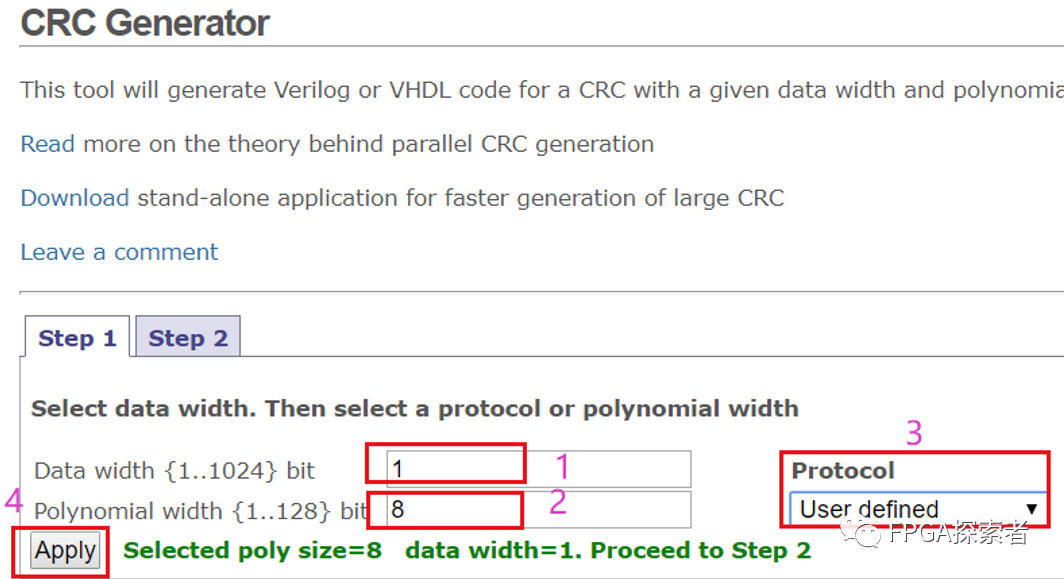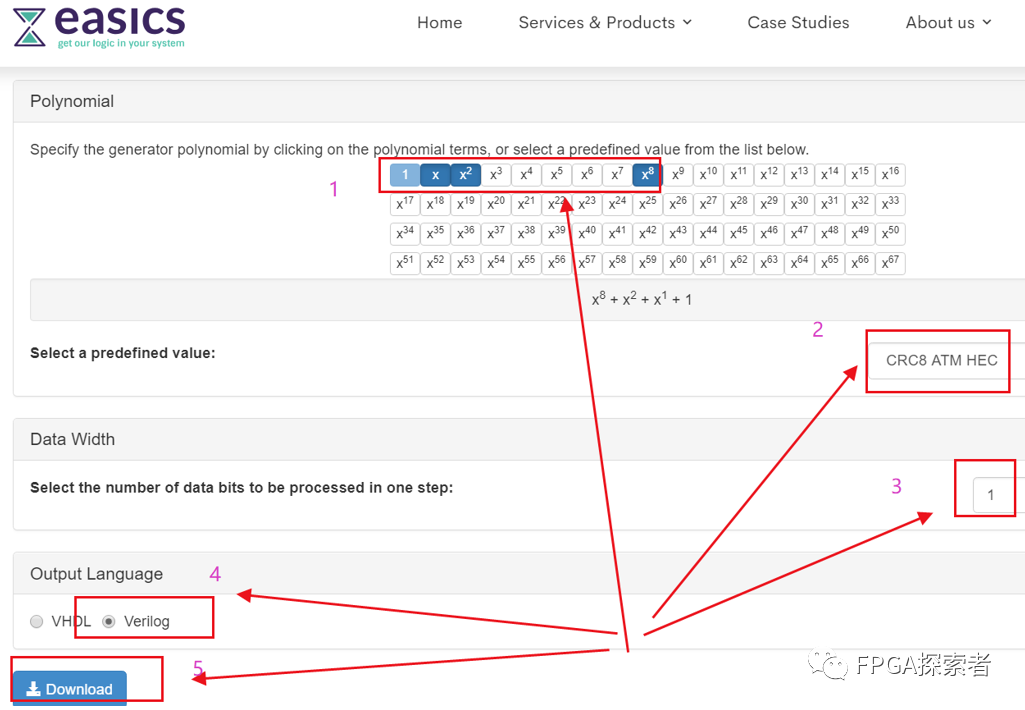

CRC校验码的多种Verilog实现方式
电子说
描述
用Verilog实现CRC-8的串行计算,G(D)=D8+D2+D+1,计算流程如下图所示:

一、分析
CRC循环冗余校验码(Cyclic Redundancy Check),检错码。
(1)该题目所述为CRC-8,即输出8位CRC校验值,给定一段长为N-bit的有效输入序列,输出(N+8)-bit的数据,其中前N-bit数据为输入的原始数据,添加的8-bit数据为CRC校验数据;
(2)该CRC-8的生成多项式为G(D)=D8+D2+D+1,对CRC进行简化表示时可以忽略最高位的D8,结合图示中三个异或运算的位置更容易理解生成多项式,8位CRC有8个寄存器C0~C7,根据多项式,C0、C1和C2的输入是由异或运算而来;

二、Verilog编程
1. 并行计算,串行输出
对于输入位宽为****1 的输入,这种方法的计算非常简单,直接根据生成多项式运算 。
( 注意! 如果输入位宽不为1,则需要根据多项式进行化简,可以生成运算逻辑和代码)
1.1 自己一步一步写
( 1 )先定义8个寄存器****reg [7:0]
reg [7:0] crc_reg_q;// 寄存器 Q 输出端
reg [7:0] crc_reg_d;// 寄存器 D 输入端
(对crc_reg_d,使用always赋值就定义成reg,使用assign就定义成wire)
( 2 )异或计算
** 寄存器0的输入** crc_reg_d[0] ,来自寄存器7的输出 crc_reg_q[7] 和数据输入****data_in 异或运算 ,即:
crc_reg_d [0] = crc_reg_q[7] ^ data_in;
同理可得:
always @ (*)
begin
crc_reg_d[0] = crc_reg_q[7] ^ data_in;
crc_reg_d[1] = crc_reg_q[7] ^ data_in ^ crc_reg_q[0];
crc_reg_d[2] = crc_reg_q[7] ^ data_in ^ crc_reg_q[1];
crc_reg_d[3] = crc_reg_q[2];
crc_reg_d[4] = crc_reg_q[3];
crc_reg_d[5] = crc_reg_q[4];
crc_reg_d[6] = crc_reg_q[5];
crc_reg_d[7] = crc_reg_q[6];
end
上述使用组合逻辑实现异或运算和数据的传递,另外,对于每个寄存器的输入到输出(D端到Q端),使用时序逻辑,并且按照题目要求,设置初始值为全1,将数据有效标志作为控制逻辑:
always @ (posedge clk)
begin
if( rst)
crc_reg_q <= 8’hff;
elsebegin
if(data_valid )
crc_reg_q<= crc_reg_d;// 输入数据有效就更新值
else
crc_reg_q<= crc_reg_q;// 输入数据无效就等待
end
end
( 3 )串行输出
上述已经实现了并行的 CRC,计算出的 CRC 结果就是直接的 8 位 CRC,按照题目要求,需要串行输出 CRC 结果。
思路:写一个计数器,当需要输出 CRC 时,串行计数输出,实现并串转换。这里,由于题目给了一个信号 crc_start,我把这个信号作为 CRC 的标志,当 data_valid 有效时表示输入的是数据,当 data_valid 无效且crc_start 有效表示数据输入完毕,该输出 CRC 了。
reg [2:0] count;
always @ (posedge clk)
begin
if(rst)begin
crc_out <= 0;
count<= 0;
end
elsebegin
if(data_valid) begin
crc_out <= data_in;
crc_valid <= 1'b0;
end
elseif(crc_start)begin
count <= count + 1'b1;
crc_out <= crc_reg_q [7-count];
crc_valid <= 1'b1;
end
elsebegin
crc_valid <= 1'b0;
end
end
end
1.2 CRC Generator自动生成

根据生成多项式,勾选1、X1、X2即可(对应1+D1+D2,最高位的D8不用管)。

//-----------------------------------------------------------------------------
// Copyright (C) 2009 OutputLogic.com
// This source file may be used and distributedwithout restriction
// provided that this copyright statement is notremoved from the file
// and that any derivative work contains theoriginal copyright notice
// and the associated disclaimer.
//
// THIS SOURCE FILE IS PROVIDED "ASIS" AND WITHOUT ANY EXPRESS
// OR IMPLIED WARRANTIES, INCLUDING, WITHOUTLIMITATION, THE IMPLIED
// WARRANTIES OF MERCHANTIBILITY AND FITNESS FORA PARTICULAR PURPOSE.
//-----------------------------------------------------------------------------
// CRC module for data[0:0] , crc[7:0]=1+x^1+x^2+x^8;
//-----------------------------------------------------------------------------
module crc(
input [0:0] data_in,
input crc_en,
output [7:0] crc_out,
input rst,
input clk);
reg [7:0] lfsr_q,lfsr_c;
assign crc_out = lfsr_q;
always @(*) begin
lfsr_c[0] = lfsr_q[7] ^ data_in[0];
lfsr_c[1] = lfsr_q[0] ^ lfsr_q[7]^ data_in[0];
lfsr_c[2] = lfsr_q[1] ^ lfsr_q[7]^ data_in[0];
lfsr_c[3] = lfsr_q[2];
lfsr_c[4] = lfsr_q[3];
lfsr_c[5] = lfsr_q[4];
lfsr_c[6] = lfsr_q[5];
lfsr_c[7] = lfsr_q[6];
end // always
always @(posedge clk, posedge rst) begin
if(rst) begin
lfsr_q <= {8{1'b1}};
end
else begin
lfsr_q <= crc_en ? lfsr_c: lfsr_q;
end
end // always
endmodule // crc
将上述代码按照题目要求改变输入输出的名称,并进行串并转换(并->串)即可。

1.3 easics自动生成
(1)1处选择CRC的生成多项式,这里与1.2的不同在于,要把最高位的D8选上,easics能识别的CRC协议更多;
(2)2处自动识别出这个CRC多项式其实是CRC8 ATM HEC协议使用的 CRC;
(3)3处设置输入数据位宽为1;
(4)选择生成Verilog代码;
(5)下载代码。

仔细阅读代码注释,注意!
convention: the first serial bit is D[0]
数据的最低位先输出 ,此代码将会把低位作为异或移出位,而上面已经提到的两种方法均是将最高位作为移出位去异或, 所以,代码中需要稍作修改 ,将d[0]改成d[7],d[1]改成d[6],…,以此类推,c[0]- c[7]不要变。
有兴趣的可以去看看【大小端问题】,在不同处理器、不同协议中非常常见。
///////////////////////////////////////////////////////////////////////////////
// Copyright (C) 1999-2008 Easics NV.
// This source file may be used and distributedwithout restriction
// provided that this copyright statement is notremoved from the file
// and that any derivative work contains theoriginal copyright notice
// and the associated disclaimer.
//
// THIS SOURCE FILE IS PROVIDED "AS IS"AND WITHOUT ANY EXPRESS
// OR IMPLIED WARRANTIES, INCLUDING, WITHOUTLIMITATION, THE IMPLIED
// WARRANTIES OF MERCHANTIBILITY AND FITNESS FOR APARTICULAR PURPOSE.
//
// Purpose : synthesizable CRC function
// *polynomial: x^8 + x^2 + x^1 + 1
// * datawidth: 1
//
// Info : tools@easics.be
// http://www.easics.com
///////////////////////////////////////////////////////////////////////////////
module CRC8_D1;
//polynomial: x^8 + x^2 + x^1 + 1
// datawidth: 1
//convention: the first serial bit is D[0]
function[7:0] nextCRC8_D1;
inputData;
input[7:0] crc;
reg [0:0]d;
reg [7:0]c;
reg [7:0]newcrc;
begin
d[0] =Data;
c = crc;
newcrc[0]= d[0] ^ c[7];
newcrc[1]= d[0] ^ c[0] ^ c[7];
newcrc[2